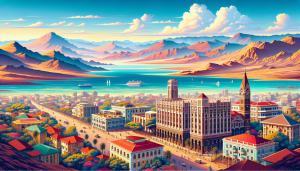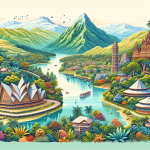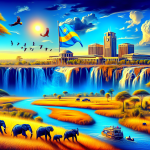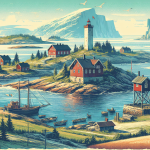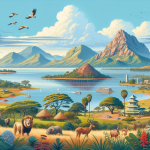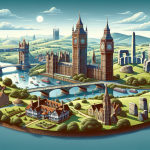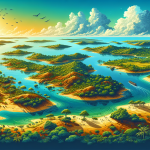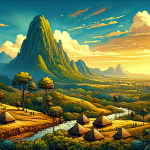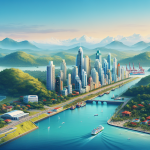Exploring Eritrea: A Hidden Gem in the Horn of Africa
Located in the Horn of Africa, Eritrea is a captivating destination that offers a blend of rich history, diverse culture, and stunning landscapes. Despite its relatively small size, this East African country brims with unique attractions that promise an unforgettable travel experience. Eritrea’s strategic location along the Red Sea has bestowed it with a vibrant maritime culture and a wealth of marine biodiversity. Whether you’re an adventure seeker, a history buff, or simply someone looking to explore uncharted territories, Eritrea has something to offer. In this comprehensive guide, we’ll dive deep into the wonders of Eritrea, from the bustling city of Asmara to the serene Dahlak Archipelago, ensuring that you get a well-rounded view of this incredible travel destination.
Asmara: The Modernist City
Asmara, the capital city of Eritrea, is often referred to as “New Rome” due to its stunning collection of Italian Modernist architecture. Walking through the streets of Asmara is like stepping back in time, with well-preserved buildings that reflect a bygone era of Italian colonial rule. The city is a UNESCO World Heritage site, and it’s easy to see why. Landmarks like the Fiat Tagliero Building, Cinema Impero, and the Asmara Cathedral showcase a unique blend of European and African architectural styles. Asmara is not just about its buildings; it’s also a cultural hub with vibrant markets, cozy cafes, and a lively arts scene. If you’re a fan of architecture and history, Asmara should be at the top of your Eritrea travel itinerary.
The Dahlak Archipelago: A Marine Paradise
The Dahlak Archipelago, located in the Red Sea, is one of Eritrea’s most stunning natural attractions. Comprising more than 200 islands, the archipelago is a paradise for marine enthusiasts. The crystal-clear waters offer excellent opportunities for snorkeling and diving, with a rich diversity of marine life, including colorful coral reefs, exotic fish, and even shipwrecks. The islands themselves are relatively untouched, providing a sense of serenity and isolation that’s hard to find elsewhere. Whether you’re exploring the underwater world or simply basking in the sun on a pristine beach, the Dahlak Archipelago offers an idyllic escape from the hustle and bustle of modern life.
Massawa: The Pearl of the Red Sea
Massawa, often dubbed as the “Pearl of the Red Sea,” is a historic port city that offers a fascinating blend of cultures and architectural styles. The city’s history dates back to ancient times, and its strategic location has made it a melting pot of influences from Africa, the Middle East, and Europe. One of the most striking features of Massawa is its Ottoman-era architecture, with buildings that showcase intricate designs and beautiful arches. The Old Town of Massawa is a maze of narrow streets, bustling markets, and historic mosques, providing a glimpse into the city’s rich cultural tapestry. For history enthusiasts, Massawa is a treasure trove of stories waiting to be discovered.
The Highlands: A Journey Through Eritrea’s Heartland
Eritrea’s highlands offer a completely different landscape compared to its coastal regions. The highlands are characterized by rugged mountains, lush valleys, and fertile farmland. This region is also home to some of the country’s most important historical and cultural sites. The town of Keren, for instance, is known for its vibrant markets and the famous Mariam Dearit Shrine, a significant pilgrimage site. The highlands are also a great place for trekking and exploring the natural beauty of Eritrea. From the dramatic cliffs of the Gheralta Mountains to the serene landscapes of the Filfil Solomuna, the highlands offer endless opportunities for adventure and discovery.
Danakil Depression: An Otherworldly Landscape
The Danakil Depression, located in the northeastern part of Eritrea, is one of the hottest and most inhospitable places on Earth. Despite its harsh conditions, the Danakil Depression is a geological wonder, featuring surreal landscapes that seem almost otherworldly. The area is known for its active volcanoes, salt flats, and colorful hot springs, making it a fascinating destination for geologists and adventurous travelers. The Erta Ale volcano, with its continuous lava lake, is one of the highlights of the region. Visiting the Danakil Depression is not for the faint of heart, but for those who dare to venture into this extreme environment, the rewards are unparalleled.
Eritrean Cuisine: A Culinary Adventure
No visit to Eritrea would be complete without indulging in the local cuisine. Eritrean food is a delightful blend of African, Middle Eastern, and Mediterranean flavors. One of the most popular dishes is **injera**, a spongy flatbread made from teff flour, which serves as the base for many meals. Injera is typically served with a variety of stews, known as **zigni** (spicy meat stew), **shiro** (chickpea stew), and **alicha** (mild vegetable stew). Seafood lovers will also find plenty to enjoy, thanks to Eritrea’s coastal location. Grilled fish, prawns, and other seafood dishes are common and often feature fresh, local ingredients. Be sure to try **t’ej**, a traditional honey wine, to complete your culinary adventure in Eritrea.
Practical Tips for Traveling to Eritrea
Visa Requirements
Most travelers will need a visa to enter Eritrea. It’s advisable to apply for your visa well in advance, as the process can take some time. Ensure that your passport is valid for at least six months beyond your planned departure date.
Best Time to Visit
The best time to visit Eritrea is during the cooler months, from October to March. During this period, the weather is more comfortable for sightseeing and outdoor activities. The summer months can be extremely hot, especially in the lowland and coastal areas.
Getting Around
Traveling within Eritrea can be challenging due to limited infrastructure. Domestic flights are available between major cities, but for exploring rural areas, renting a car or hiring a local guide is recommended. Public transportation options are limited, and road conditions can vary.
Health and Safety
It’s important to take health precautions when traveling to Eritrea. Make sure you’re up-to-date on routine vaccines, and consider vaccinations for hepatitis A, typhoid, and malaria, depending on your travel itinerary. Drink bottled water and avoid raw or undercooked foods to reduce the risk of foodborne illnesses. As with any travel destination, stay aware of your surroundings and take basic safety precautions.
Conclusion: Why Eritrea Should Be Your Next Travel Destination
Eritrea is a hidden gem that offers a unique and enriching travel experience. From the architectural wonders of Asmara to the natural beauty of the Dahlak Archipelago and the historical richness of Massawa, this East African country has something for every traveler. The diverse landscapes, rich cultural heritage, and warm hospitality of the Eritrean people make it a destination worth exploring. Whether you’re an adventurer, a history enthusiast, or a culinary explorer, Eritrea promises a journey filled with discovery and delight. So why wait? Pack your bags and set off on an unforgettable adventure to Eritrea.
For more detailed travel information, you can visit Lonely Planet’s Eritrea Travel Guide.
